Profiling Human-Induced Vegetation Change in the Horqin Sandy Land of China Using Time Series Datasets
Abstract
1. Introduction
2. Materials and Methods
2.1. Study Area
2.2. Data and Data Preprocessing
2.3. Methodology
2.3.1. Detecting Vegetation Dynamics Using the SMK Method
2.3.2. Discriminating Human-Induced Changes Using Optimized RESTREND
3. Results
3.1. Vegetation Dynamics during the Past 15 Years
3.2. Human-Induced Vegetation Changes
3.2.1. Significant Human-Induced Change in the Ar Horqin Region
3.2.2. Significant Human-Induced Change in the Naiman Region
3.2.3. Validation of Human-Induced Vegetation Change
4. Discussion
4.1. Different Driving Factors in the Study Areas
4.2. Limitations and Further Research
5. Conclusions
Acknowledgments
Author Contributions
Conflicts of Interest
References
- Evans, J.; Geerken, R. Discrimination between climate and human-induced dryland degradation. J. Arid Environ. 2004, 57, 535–554. [Google Scholar] [CrossRef]
- Omuto, C.T.; Vargas, R.R.; Alim, M.S.; Paron, P. Mixed-effects modelling of time series NDVI-rainfall relationship for detecting human-induced loss of vegetation cover in drylands. J. Arid Environ. 2010, 74, 1552–1563. [Google Scholar] [CrossRef]
- Marchant, R.; Richer, S.; Capitani, C.; Courtney-Mustaphi, C.; Prendergast, M.; Stump, D.; Boles, O.; Lane, L.; Wynne-Jones, S.; Vázquez, C.F.; et al. Drivers and trajectories of land cover change in East Africa: Human and environmental interactions from 6000 years ago to present. Earth Sci. Rev. 2018, 178, 322–378. [Google Scholar] [CrossRef]
- Zhou, X.; Yamaguchi, Y.; Arjasakusuma, S. Distinguishing the vegetation dynamics induced by anthropogenic factors using vegetation optical depth and AVHRR NDVI: A cross-border study on the Mongolian Plateau. Sci. Total Environ. 2018, 616–617, 730–743. [Google Scholar] [CrossRef] [PubMed]
- Wang, H.; Liu, G.H.; Li, Z.S.; Ye, X.; Fu, B.J.; Lv, Y.H. Impacts of Drought and Human Activity on Vegetation Growth in the Grain for Green Program Region, China. Chin. Geogr. Sci. 2018. [Google Scholar] [CrossRef]
- Pearson, R.G.; Phillips, S.J.; Loranty, M.M.; Beck, P.S.A.; Damoulas, T.; Knight, S.J.; Goetz, S.J. Shifts in Arctic vegetation and associated feedbacks under-climate change. Nat. Clim. Chang. 2013, 3, 673–677. [Google Scholar] [CrossRef]
- Dewan, A.M.; Yamaguchi, Y. Land use and land cover change in Greater Dhaka, Bangladesh: Using remote sensing to promote sustainable urbanization. Appl. Geogr. 2009, 29, 390–401. [Google Scholar] [CrossRef]
- Byomkesh, T.; Nakagoshi, N.; Dewan, A.M. Urbanization and green space dynamics in Greater Dhaka, Bangladesh. Landsc. Ecol. Eng. 2012, 8, 45–58. [Google Scholar] [CrossRef]
- Rêgo, J.C.L.; Soares-Gomes, A.; Silva, F.S. Loss of vegetation cover in a tropical island of the Amazon coastal zone (Maranhão Island, Brazil). Land Use Policy 2017. [Google Scholar] [CrossRef]
- Tong, X.W.; Brandt, M.; Yue, Y.M.; Horion, S.; Wang, K.L.; Keersmaecker, W.D.; Tian, F.; Schurgers, G.; Xiao, X.M.; Luo, Y.Q.; et al. Increased vegetation growth and carbon stock in China karst via ecological engineering. Nat. Sustain. 2018, 1, 44–50. [Google Scholar] [CrossRef]
- Xu, L.L.; Li, B.L.; Yuan, Y.C.; Gao, X.Z.; Zhang, T.; Sun, Q.L. Detecting Different Types of Directional Land Cover Changes Using MODIS NDVI Time Series Dataset. Remote Sens. 2016, 8, 495. [Google Scholar] [CrossRef]
- Fisher, R.A.; Koven, C.D.; Anderegg, W.; Christoffersen, B.O.; Dietze, M.C.; Farrior, C.; Holm, J.A.; Hurtt, G.; Knox, R.G.; Lawrence, P.J.; et al. Vegetation Demographics in Earth System Models: A review of progress and priorities. Glob. Chang. Biol. 2017, 24, 35–54. [Google Scholar] [CrossRef] [PubMed]
- Wessels, K.J.; Pretorius, D.J.; Prince, S.D. Reality of rangeland degradation mapping with remote sensing: The South African experience. In Proceedings of the 14th Australasian Remote Sensing and Photogrammetry Conference, Darwin, Australia, 29 September–3 October 2008. [Google Scholar]
- Wang, Y.W.; Wang, Z.Y.; Li, R.R.; Meng, X.L.; Ju, X.J.; Zhao, Y.G.; Sha, Z.Y. Comparison of Modeling Grassland Degradation with and without Considering Localized Spatial Associations in Vegetation Changing Patterns. Sustainability 2018, 10, 316. [Google Scholar] [CrossRef]
- Marignani, M.; Chiarucci, A.; Sadori, L.; Mercuri, A.M. Natural and human impact in Mediterranean landscapes: An intriguing puzzle or only a question of time? Plant Biosyst. 2017, 151, 900–905. [Google Scholar] [CrossRef]
- Mercuri, A.M. Genesis and evolution of the cultural landscape in central Mediterranean: The ‘where, when and how’ through the palynological approach. Landsc. Ecol. 2014, 29, 1799–1810. [Google Scholar] [CrossRef]
- Turner, B.; Benjamin, P. Fragile Lands: Identification and Use for Agriculture: Agriculture, Environment, and Health: Sustainable Development in the 21st Century; University of Minnesota Press: Minneapolis, MN, USA; London, UK, 1994. [Google Scholar]
- Wessels, K.J.; Prince, S.D.; Frost, P.E.; Zyl, D.V. Assessing the effects of human-induced land degradation in the former homelands of northern South Africa with a 1 km AVHRR NDVI time-series. Remote Sens. Environ. 2004, 91, 47–67. [Google Scholar] [CrossRef]
- Guo, Z.L.; Huang, N.; Dong, Z.B.; Pelt, R.S.V.; Zobeck, T.M. Wind Erosion Induced Soil Degradation in Northern China: Status, Measures and Perspective. Sustainability 2014, 6, 8951–8966. [Google Scholar] [CrossRef]
- Petit, C.; Scudder, T.; Lambin, E. Quantifying processes of land-cover change by remote sensing: Resettlement and rapid land-cover changes in south-eastern Zambia. Int. J. Remote Sens. 2001, 22, 3435–3456. [Google Scholar] [CrossRef]
- Tian, F.; Fensholt, R.; Verbesselt, J.; Grogan, K.; Horion, S.; Wang, Y.J. Evaluating temporal consistency of long-term global NDVI datasets for trend analysis. Remote Sens. Environ. 2015, 163, 326–340. [Google Scholar] [CrossRef]
- Lyon, J.G.; Yuan, D.; Lunetta, R.S.; Elvidge, C.D. A change detection experiment using vegetation indices. Photogramm. Eng. Remote Sens. 1998, 64, 143–150. [Google Scholar]
- Shi, X.; Wang, W.; Shi, W. Progress on quantitative assessment of the impacts of climate change and human activities on cropland change. J. Geogr Sci. 2016, 26, 339–354. [Google Scholar] [CrossRef]
- Houerou, H.N.L. Rain-Use Efficiency: A Unifying Concept in Arid-Land Ecology. J. Arid Environ. 1984, 7, 213–247. [Google Scholar]
- Prince, S.D.; Colstoun, D.; Brown, E.; Kravitz, L.L. Evidence from rain-use efficiencies does not indicate extensive sahelian desertification. Glob. Chang. Biol. 1998, 4, 359–374. [Google Scholar] [CrossRef]
- Dardel, C.; Kergoat, L.; Hiernaux, P.; Grippa, M.; Mougin, E.; Ciais, P.; Nguyen, C.C. Rain-Use-Efficiency: What It Tells Us about the Conflicting Sahel Greening and Sahelian Paradox. Remote Sens. 2014, 6, 3446–3474. [Google Scholar] [CrossRef]
- Li, A.; Wu, J.; Huang, J. Distinguishing between human-induced and climate-driven vegetation changes: A critical application of RESTREND in inner Mongolia. Landsc. Ecol. 2012, 27, 969–982. [Google Scholar] [CrossRef]
- Wessels, K.J.; Van Den Bergh, F.; Scholes, R.J. Limits to detectability of land degradation by trend analysis of vegetation index data. Remote Sens. Environ. 2012, 125, 10–22. [Google Scholar] [CrossRef]
- Wessels, K.J.; Prince, S.D.; Malherbe, J.; Small, J.; Frost, P.E.; Vanzyl, D. Can human-induced land degradation be distinguished from the effects of rainfall variability? A case study in South Africa. J. Arid Environ. 2007, 68, 271–297. [Google Scholar] [CrossRef]
- Wessels, K.J.; Prince, S.D.; Zambatis, N.; MacFadyen, S.; Frost, P.E.; Vanzyl, D. Relationship between herbaceous biomass and 1-km2 Advanced Very High Resolution Radiometer (AVHRR) NDVI in Kruger National Park, South Africa. Int. J. Remote Sens. 2006, 27, 951–973. [Google Scholar] [CrossRef]
- Zhuo, L.; Cao, X.; Chen, J.; Chen, Z.X.; Shi, P.J. Assessment of grassland ecological restoration project in Xilin Gol grassland. Acta Geogr. Sin. 2007, 62, 471–480. (In Chinese) [Google Scholar]
- Prince, S.D.; Becker-Reshef, I.; Rishmawi, K. Detection and mapping of long-term land degradation using local net production scaling: Application to Zimbabwe. Remote Sens. Environ. 2009, 113, 1046–1057. [Google Scholar] [CrossRef]
- He, C.Y.; Tian, J.; Gao, B.; Zhao, Y.Y. Differentiating climate- and human-induced drivers of grassland degradation in the Liao River Basin, China. Environ. Monit. Assess. 2015, 187, 1–14. [Google Scholar] [CrossRef] [PubMed]
- Han, Z.; Wang, T.; Yan, C.; Yan, C.Z.; Liu, Y.B.; Liu, L.C.; Li, A.M.; Du, H.Q. Change trends for desertified lands in the Horqin Sandy Land at the beginning of the twenty-first century. Environ. Earth Sci. 2010, 59, 1749–1757. [Google Scholar] [CrossRef]
- Yan, Q.L.; Zhu, J.J.; Hu, Z.B.; Sun, O.J. Environmental impacts of the shelter forests in Horqin Sandy land, northeast China. J. Environ. Qual. 2011, 40, 815. [Google Scholar] [CrossRef] [PubMed]
- Zhang, G.; Dong, J.W.; Xiao, X.M.; Hu, Z.M.; Sheldon, S. Effectiveness of ecological restoration projects in Horqin Sandy Land, China Based on SPOT-VGT NDVI data. Ecol. Eng. 2012, 38, 20–29. [Google Scholar] [CrossRef]
- Yan, Q.L.; Zhu, J.J.; Zheng, X.; Jin, C.J. Causal effects of shelter forests and water factors on desertification control during 2000–2010 at the Horqin Sandy Land region, China. J. For. Res. 2015, 26, 33–45. [Google Scholar] [CrossRef]
- Chen, H.B.; Shao, L.Q.; Zhao, M.J.; Zhang, X.; Zhang, D.J. Grassland conservation programs, vegetation rehabilitation and spatial dependency in Inner Mongolia, China. Land Use Policy 2017, 64, 429–439. [Google Scholar] [CrossRef]
- Xu, L.L.; Li, B.L.; Yuan, Y.C.; Gao, X.Z.; Zhang, T. A. Temporal-Spatial Iteration Method to Reconstruct NDVI Time Series Datasets. Remote Sens. 2015, 7, 8906–8924. [Google Scholar] [CrossRef]
- Higginbottom, T.P.; Symeonakis, E. Assessing Land Degradation and Desertification Using Vegetation Index Data: Current Frameworks and Future Directions. Remote Sens. 2014, 6, 481–493. [Google Scholar] [CrossRef]
- Landmann, T.; Dubovyk, O. Spatial analysis of human-induced vegetation productivity decline over eastern Africa using a decade (2001–2011) of medium resolution MODIS time-series data. Int. J. Appl. Earth Obs. 2014, 33, 76–82. [Google Scholar] [CrossRef]
- Ibrahim, Y.Z.; Balzter, H.; Kaduk, J.; Tucker, C.J. Land Degradation Assessment Using Residual Trend Analysis of GIMMS NDVI3g, Soil Moisture and Rainfall in Sub-Saharan West Africa from 1982 to 2012. Remote Sens. 2015, 7, 5471–5494. [Google Scholar] [CrossRef]
- Savitzky, A.; Golay, M.J.E. Smoothing and Differentiation of Data by Simplified Least Squares Procedures. Anal. Chem. 1964, 36, 1627–1639. [Google Scholar] [CrossRef]
- Chen, J.; Jönsson, P.; Tamura, M.; Gu, Z.H.; Matsushita, B.; Eklundh, L. A simple method for reconstructing a high-quality NDVI time-series data set based on the Savitzky-Golay filter. Remote Sens. Environ. 2004, 91, 332–344. [Google Scholar] [CrossRef]
- Fang, J.; Piao, S.; He, J.; Ma, W.H. Increasing terrestrial vegetation activity in China, 1982–1999. Sci. China Life Sci. 2004, 47, 229–240. [Google Scholar] [CrossRef]
- Song, Y.; Ma, M.G. A statistical analysis of the relationship between climatic factors and the Normalized Difference Vegetation Index in China. Int. J. Remote Sens. 2011, 45, 374–382. [Google Scholar] [CrossRef]
- Du, J.Q.; Shu, J.M.; Yin, J.Q.; Yuan, X.J.; Jiaerheng, A.; Xiong, S.S.; He, P.; Liu, W.L. Analysis on spatio-temporal trends and drivers in vegetation growth during recent decades in Xinjiang, China. Int. J. Appl. Earth Obs. 2015, 38, 216–228. [Google Scholar] [CrossRef]
- Xu, L.L.; Li, B.L.; Yuan, Y.C.; Gao, X.Z.; Liu, H.J.; Dong, G.H. Changes in China’s cultivated land and the evaluation of land requisition-compensation balance policy from 2000 to 2010. Resour. Sci. 2015, 37, 1543–1551. (In Chinese) [Google Scholar]
- Fensholt, R.; Rasmussen, K.; Nielsen, T.T.; Mbow, C. Evaluation of earth observation based long term vegetation trends-Intercomparing NDVI time series trend analysis consistency of Sahel from AVHRR GIMMS, Terra MODIS and SPOT VGT data. Remote Sens. Environ. 2009, 113, 1886–1898. [Google Scholar] [CrossRef]
- Wang, H.Y.; Li, Z.Y.; Gao, Z.H.; Wu, J.J.; Sun, B.; Li, C.L. Assessment of land degradation using time series trend analysis of vegetation indictors in Otindag Sandy land. In Proceedings of the 35th IOP Conference Series: Earth and Environmental Science, Beijing, China, 22–26 April 2013; p. 17. [Google Scholar]
- Olsson, L.; Eklundh, L.; Ardo, J. A recent greening of the Sahel-trends, patterns and potential causes. J. Arid Environ. 2005, 63, 556–566. [Google Scholar] [CrossRef]
- Ahmedou, O.C.A.; Nagasawa, R.; Osman, A.E.; Hattori, K. Rainfall variability and vegetation dynamics in the Mauritanian Sahel. Clim. Res. 2009, 38, 75–81. [Google Scholar] [CrossRef]
- Li, Z.; Huffman, T.; Mcconkey, B.; Townley-Smith, L. Monitoring and modeling spatial and temporal patterns of grassland dynamics using time-series MODIS NDVI with climate and stocking data. Remote Sens. Environ. 2013, 138, 232–244. [Google Scholar] [CrossRef]
- Beurs, K.M.; de Henebry, G.M. A statistical framework for the analysis of long image time series. Int. J. Remote Sens. 2005, 26, 1551–1573. [Google Scholar] [CrossRef]
- Cai, B.F.; Yu, R. Advance and evaluation in the long time series vegetation trends research based on remote sensing. J. Remote Sens. 2009, 13, 1170–1186. (In Chinese) [Google Scholar]
- Zhu, Z.; Woodcock, C.E. Continuous change detection and classification of land cover using all available Landsat data. Remote Sens. Environ. 2014, 144, 152–171. [Google Scholar] [CrossRef]
- Jamali, S.; Jönsson, P.; Eklundh, L.; Ardo, J.; Seaquist, J. Detecting changes in vegetation trends using time series segmentation. Remote Sens. Environ. 2015, 156, 182–195. [Google Scholar] [CrossRef]
- De Jong, R.; Verbesselt, J.; Zeileis, A.; Schaepman, M.E. Shifts in global vegetation activity trends. Remote Sens. 2013, 5, 1117–1133. [Google Scholar] [CrossRef]
- Wei, Y.; Lin, H.L.; Wang, X.Y. Analysis of the impact of price factors on livestock output in China. J. Gansu Radio TV Univ. 2016, 26, 83–86. (In Chinese) [Google Scholar]
- Li, F.; Lawrence, D.M.; Bond-Lamberty, B. Human impacts on 20th century fire dynamics and implications for global carbon and water trajectories. Glob. Planet. Chang. 2018, 162, 18–27. [Google Scholar] [CrossRef]
- Veenendaal, E.M.; Torelloraventos, M.; Miranda, H.S.; Margaretesato, N.; Oliveras, I.; Langevelde, F.V.; Asner, G.P.; Lloyd, J. On the relationship between fire regime and vegetation structure in the tropics. New Phytol. 2018, 218, 153–166. [Google Scholar] [CrossRef] [PubMed]
- Li, T.; Wang, J.D.; Zhou, H.M.; Wang, J. Automatic detection of forest fire disturbance based on dynamic modeling from MODIS time-series observations. Int. J. Remote Sens. 2018, 39, 3801–3815. [Google Scholar] [CrossRef]
- Song, Y.; Jin, L.; Wang, H. Vegetation Changes along the Qinghai-Tibet Plateau Engineering Corridor since 2000 Induced by Climate Change and Human Activities. Remote Sens. 2018, 10, 95. [Google Scholar] [CrossRef]
- Yang, L.H.; Zhou, J.; Zhong, P.L.; Long, H.; Zhang, J.R. Lateglacial and Holocene dune evolution in the Horqin dunefield of northeastern China based on luminescence dating. Palaeogeogr. Palaeoclimatol. Palaeoecol. 2010, 296, 44–51. [Google Scholar] [CrossRef]
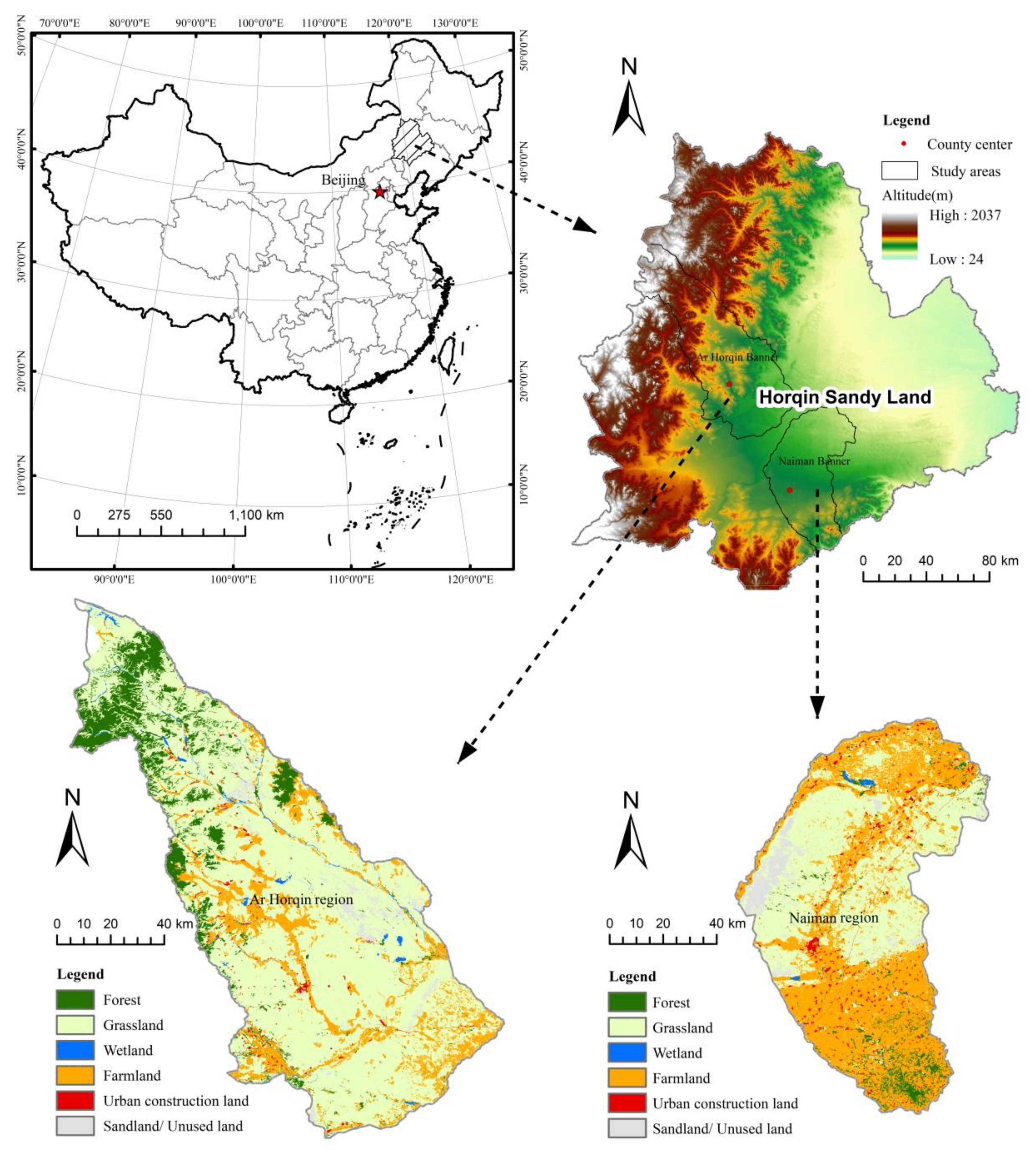




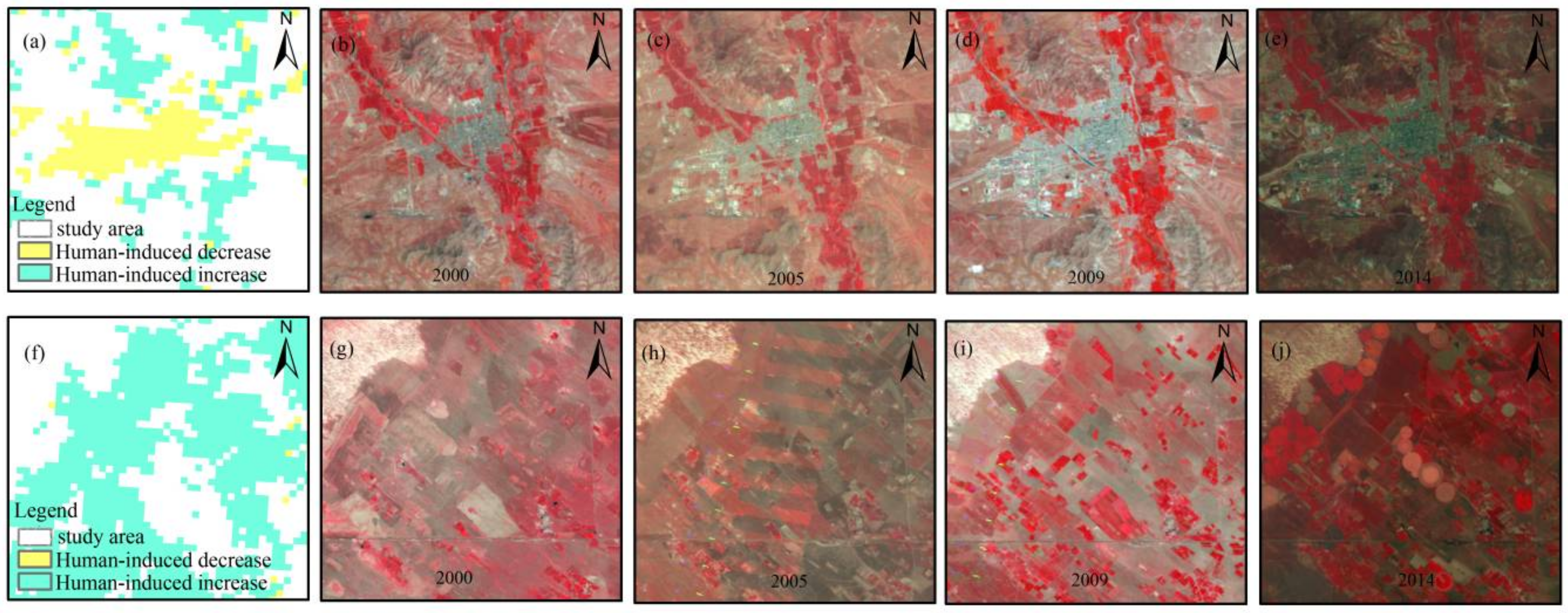
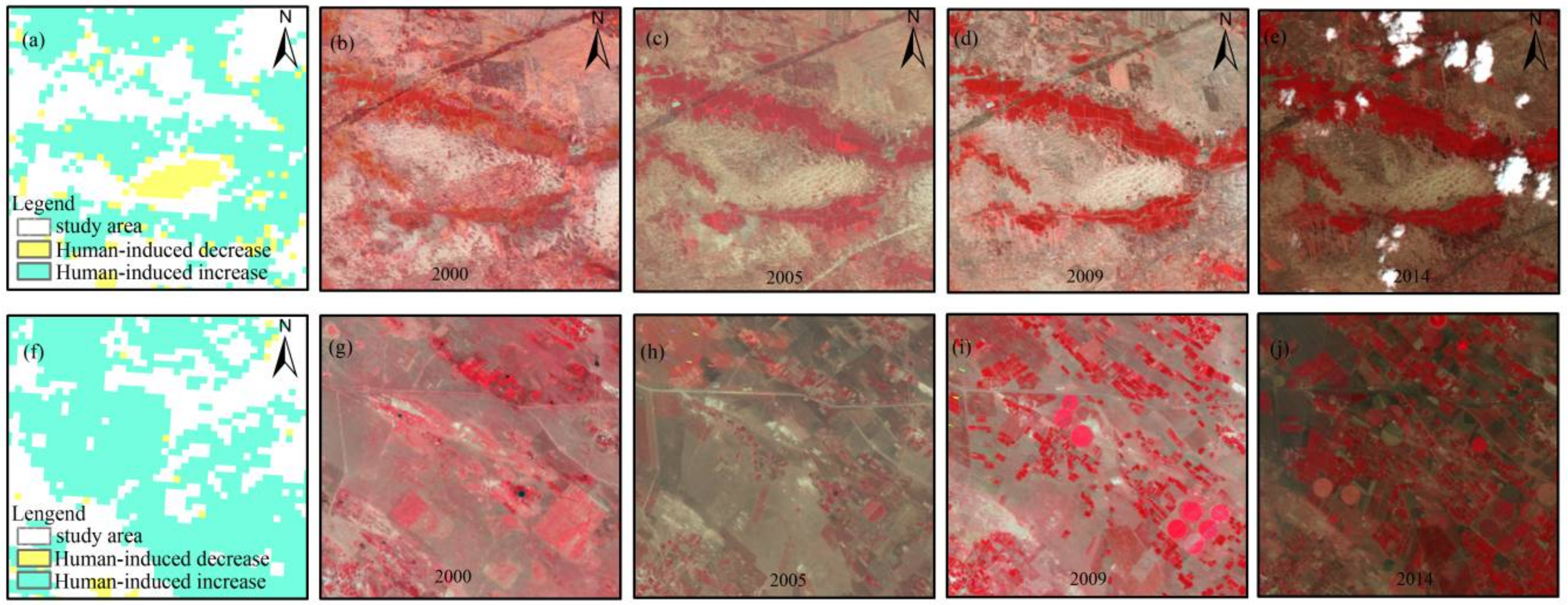
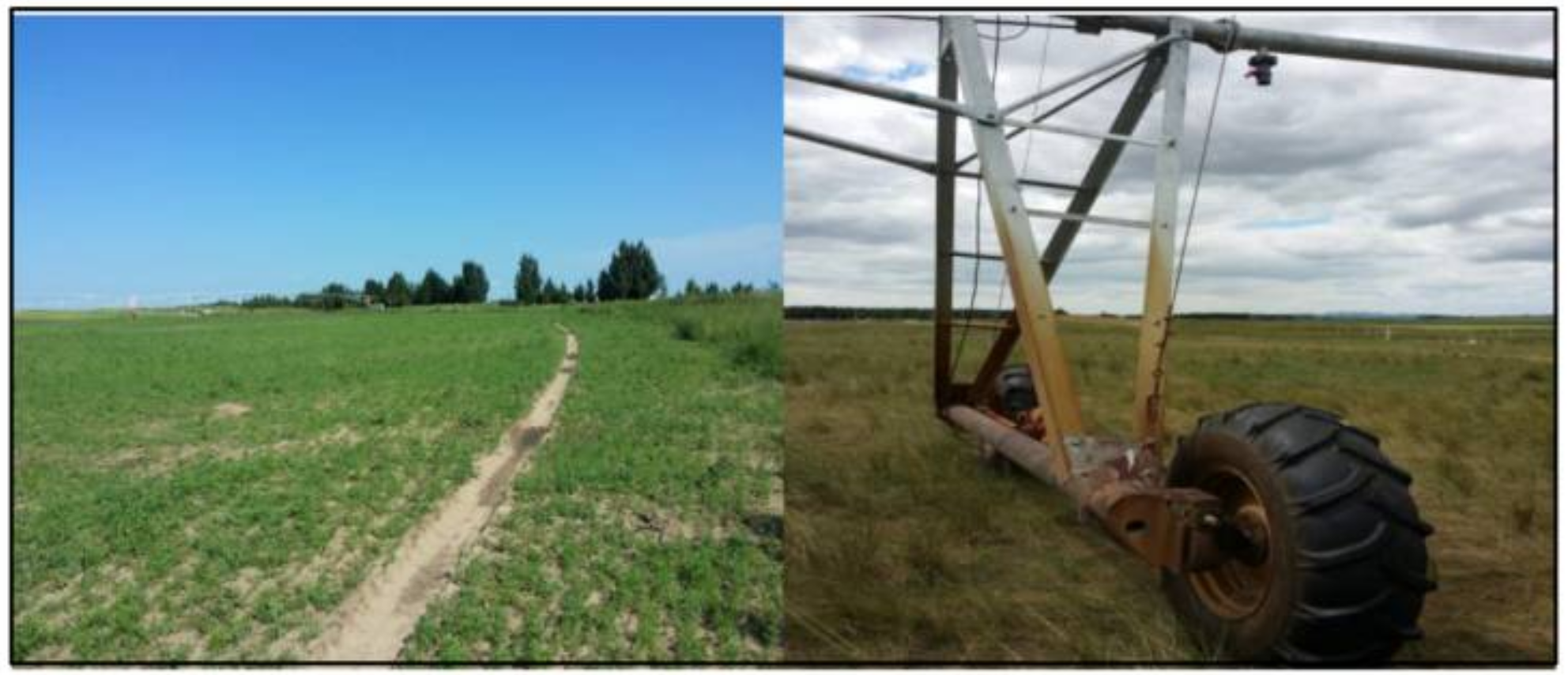
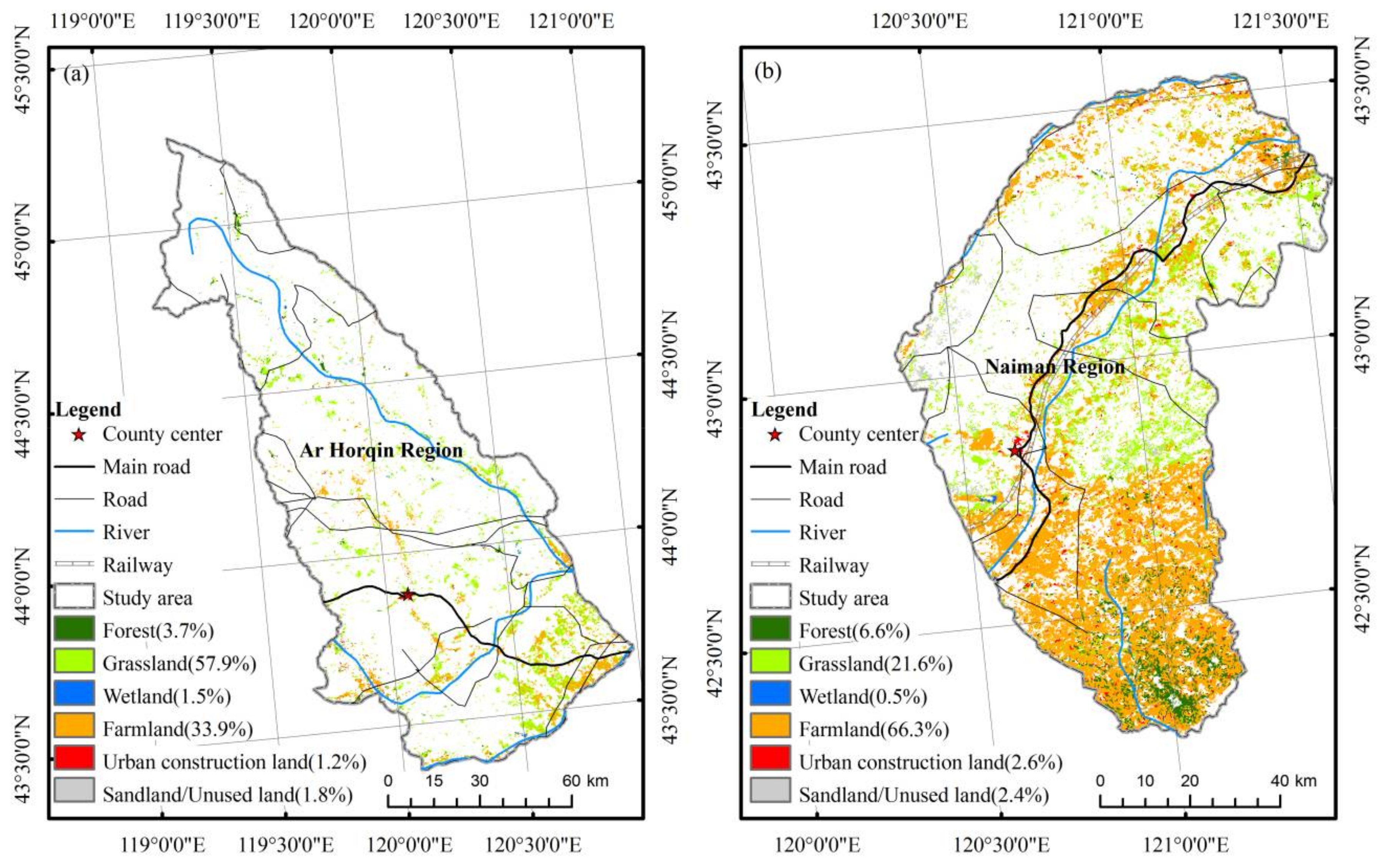

| Accumulated | Code of Indices 1 | Total |
|---|---|---|
| One month | 1, 2, 3, 4, 5, 6, 7, 8, 9 | 9 |
| Two months | 12, 23, 34, 45, 56, 67, 78, 89 | 8 |
| Three months | 123, 234, 345, 456, 567, 678, 789 | 7 |
| Four months | 1234, 2345, 3456, 4567, 5678, 6789 | 6 |
| Five months | 12345, 23456, 34567, 45678, 56789 | 5 |
| Six months | 123456, 234567, 345678, 456789 | 4 |
| Seven months | 1234567, 2345678, 3456789 | 3 |
| Eight months | 12345678, 23456789 | 2 |
| Nine months | 123456789 | 1 |
| Total | --- | 45 |
| Significant Trend Change () | Ar Horqin Region | Naiman Region | ||
|---|---|---|---|---|
| Rate (%) | Area (km2) | Rate (%) | Area (km2) | |
| <−40% | 0.1 | 17.6 | 0.0 | 3.2 |
| −40–−20% | 0.7 | 88.1 | 0.5 | 40.0 |
| −20–−10% | 0.5 | 61.5 | 0.6 | 46.8 |
| −10–10% | 0.5 | 61.0 | 1.1 | 89.0 |
| 10–20% | 2.2 | 281.2 | 14.2 | 1133.0 |
| 20–40% | 7.7 | 983.8 | 34.0 | 2717.4 |
| >40% | 6.9 | 877.9 | 15.9 | 1272.6 |
| Total | 18.6 | 2371.1 | 66.3 | 5301.9 |
© 2018 by the authors. Licensee MDPI, Basel, Switzerland. This article is an open access article distributed under the terms and conditions of the Creative Commons Attribution (CC BY) license (http://creativecommons.org/licenses/by/4.0/).
Share and Cite
Xu, L.; Tu, Z.; Zhou, Y.; Yu, G. Profiling Human-Induced Vegetation Change in the Horqin Sandy Land of China Using Time Series Datasets. Sustainability 2018, 10, 1068. https://doi.org/10.3390/su10041068
Xu L, Tu Z, Zhou Y, Yu G. Profiling Human-Induced Vegetation Change in the Horqin Sandy Land of China Using Time Series Datasets. Sustainability. 2018; 10(4):1068. https://doi.org/10.3390/su10041068
Chicago/Turabian StyleXu, Lili, Zhenfa Tu, Yuke Zhou, and Guangming Yu. 2018. "Profiling Human-Induced Vegetation Change in the Horqin Sandy Land of China Using Time Series Datasets" Sustainability 10, no. 4: 1068. https://doi.org/10.3390/su10041068
APA StyleXu, L., Tu, Z., Zhou, Y., & Yu, G. (2018). Profiling Human-Induced Vegetation Change in the Horqin Sandy Land of China Using Time Series Datasets. Sustainability, 10(4), 1068. https://doi.org/10.3390/su10041068







